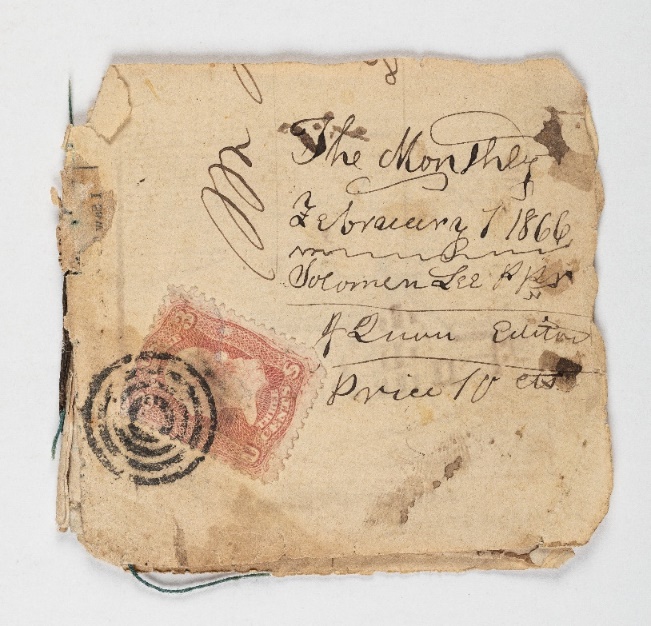Children often wrote and commented on serious social and political events, both national and international. In this way, they attempted to emulate contemporary printed newspapers created by adults. Despite this, children still added playfulness to their writings as most newspapers include original puzzles, jokes, and riddles. The puzzles often were about friends or peers of the editors, especially on those newspapers created as part of a school project. Two newspapers that illustrate this are The Souvenir, edited by Wentworth and Lilyputt, and The Monthly, edited by John Quan and printed by J. Corr and Solomen Lee.
The Souvenir

The Souvenir was edited and published by Wentworth and Lilyputt in Portsmouth, New Hampshire in 1874. They divided the work of writing the articles, assigning the first two pages to Lilyputt and the other two pages to Wentworth. Lilyputt writes about visiting Boston and Lynn, Massachusetts, attending picnics and chowder parties, rowing in several rivers, and going to a photo studio. Wentworth recounts his dissatisfaction with his first picnic party. However, he enjoyed his subsequent picnic parties by spending much time with his friends. Lastly, he describes his anecdotes while traveling across New England. Both editors include a rhymes section in the paper which mentions the names of other children, likely their friends. These include Lillie, Rodger, Ella, Minnie White, Will, and Deming. The rhymes tell the story of a rowing trip through a stream and describes what each of the friends do. The last stanza reads, "To 'Frankfort,' trip no. 1 was made When we danced upon a plank With Will & Deming like wall flowers Blooming in the sand bank."
Portsmouth was first incorporated as a town in 1653 and as a city in 1849. In the early 19th century, the city was one of the busiest ports in the northeast and had an important shipbuilding industry. The economic prosperity was reflected on the fine architecture of its buildings, including examples of Colonial, Georgian, and Federal styles. The city center had buildings made from brick due to a devastating fire in 1813. However, with the advent of river-powered mills built in inland towns during the mid-19th century, the economy of Portsmouth declined. As it headed into the 20th century, its focus shifted towards historic preservation of its architecture.
The Monthly

The Monthly was edited by John Quan and printed by J. Corr and Solomen Lee in Dingmans Ferry, Pennsylvania in 1866. It is believed that these were pen names or pseudonyms and not their real names. This newspaper is unique since it was made using repurposed envelopes and scrap paper, which was cut into small pieces and tied together with a string. The front cover of the two issues has ink stamps, pasted mail stamps, and writing in ink from the original owners of the envelopes. Despite the small size of the paper, the editor and contributors included a variety of articles, stories, advertisements, puzzles, and drawings. The puzzles include riddles and conundrums, with the answer to the previous month's puzzle at the bottom of the page. The second issue contains an illustrated puzzle in which the editor uses original drawings to communicate the clues of the riddle. Both the writings and drawings are indicated as "copyrighted" by the editor and printers.
The town of Dingmans Ferry was established in 1735 by Dutchman Andrew Dingman of Kinderhook, New York. He operated a ferry service between the Pennsylvania and New Jersey sides of the Delaware River, which played an important role in the French and Indian War. The Dingmans Choice and Delaware Bridge Company was formed in 1834 and granted a charter to build a bridge. A wooden bridge was finished in 1836 but came down in 1847 after a major flood. The two bridges that were subsequently built were also destroyed by floods. The ferry resumed operation after each time the bridge collapsed. It remained in service until 1900, when the Perkins brothers from the Horseheads Bridge Company of Horseheads, New York bought a large share of the company and financed the construction of a new steel bridge. This fourth bridge withstood multiple floods and is still in use today. It is one of the last few privately owned bridges in the country.
Suggested Classroom Questions and Activities
- What formats did children choose to write their puzzles?
- What topics and themes did they use in their puzzles?
- Did the children mention contemporary events in their puzzles? If so, which events?
- What can you learn about 19th century children from the puzzles?
- Ask your students to create their own puzzles. These can be conundrums, riddles, wordplay, jokes, anecdotes, and/or rhymes. The characters and situations can be completely made up or can be their fellow classmates.
- To expand, ask them to share their puzzles with the class. This can be done either in small groups or to the whole class.
Additionally, ask your students to select their favorite puzzles and describe why they liked them. This can be done by writing or speaking.
(CCSS.ELA-LITERACY.RL.3.4 Determine the meaning of words and phrases as they are used in a text, distinguishing literal from nonliteral language).
(CCSS.ELA-LITERACY.SL.3.1.B Follow agreed-upon rules for discussions (e.g., gaining the floor in respectful ways, listening to others with care, speaking one at a time about the topics and texts under discussion)).
(CCSS.ELA-LITERACY.SL.3.1.C Ask questions to check understanding of information presented, stay on topic, and link their comments to the remarks of others).